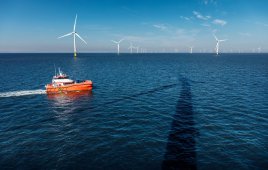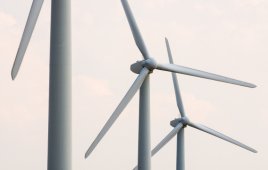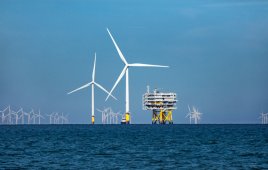
Electrical fires in wind turbines can result from shorts in equipment and surges from lightning strikes. Secondary wind-driven brush fires can also result in additional damage.
Scott Starr | Director of Marketing
Firetrace International
Fire provides the second highest risk of damage to wind turbines after blade failure. A fire can spark because of mechanical failure, electrical malfunction, or a lightning strike. These sparks can ignite flammable materials inside the nacelle such as resin, fiberglass, or insulation contaminated with oil deposits.
Once a turbine catches fire, there are limited suppression options because of the height of the tower and remote location of most turbines. Unless the nacelle is already equipped with a fire-suppression system, about the only option is to let the fire burn out.
Considering a 2.5 to 3.0-MW commercial-scale wind turbine is valued at $3 to $4 million, with an output averaging $2,800 per day, fire damage equates to a serious loss in ROI for owners. Larger fires can result in a complete loss of a turbine, but even minor fires and power surges can lead to weeks of downtime and lost revenue.
The problem is bigger than most people and even those in the industry realize because most turbine fires go unreported. In the last four years, 30 large wind-turbine fire incidents were covered in the mainstream media, causing property damage of between $750,000 to $6 million each, including loss of productivity.
So what options do wind-farm owners have to protect themselves against fire risks and potential investment losses? Several ideas have been tried and tested in the wind industry, such as increasing the number of maintenance checks, avoiding use of combustible materials, installing condition monitoring and lightning-protection systems, and completely redesigning wind turbines. The problem is that all of these measures involve a substantial investment increase.
Today, many owners and operators are taking no chances and so incorporate some type of automatic fire-detection or suppression system in their turbines. Cost varies depending on the system and manufacturer but, on average, fire suppression is less than 1% of the value of a wind turbine.
Whether detecting or suppressing a fire, most systems can make a difference, but they come with their fair share of design challenges. They must tolerate dust, vibration, temperature and weather fluctuations, and they must limit the number of false alarms that occur. Of the many types of fire detection available, some use smoke-detection or air-sampling systems. These systems are ideal for detecting initial flames, but fluctuating airflows and varying climate conditions can impact their effectiveness.

Traditional fire-suppression systems are impractical because of their weight and the impact of the turbine environment, which includes vibration, temperature extremes, dust, and airflow. The Firetrace fire-suppression system uses linear pneumatic detection tubing (red) routed through the most likely areas of a fire. When it detects high heat or flame, the tubing releases a clean agent that suppresses the fire without affecting the health of workers or equipment.
Traditional linear heat-detection systems and fusible link-detection systems (designed to activate when temperatures increase to the point that causes the fusible link to break apart) provide an alternative and aren’t affected by air or dust. However, they are electrically conductive and provide some risk in a turbine environment. All of these detection devices also come with power and control requirements, which means that these systems will shutdown when the external power or battery backup fails.
Several fire-suppressing agent types have also undergone evaluation for use in wind-turbine applications. Compressed airfoam systems and water mists are examples of common suppression products. But concerns in the wind industry about their effectiveness on energized electrical components and potential corrosion hazards have limited their use in turbines.
Carbon dioxide also holds attributes that make for an effective fire-suppression system. It has a high rate of expansion and can act quickly on fires. However it comes with serious risks to personnel because it depletes oxygen when in use, so an alternative is preferable when possible. Strict regulations and lockout requirements are associated with carbon-dioxide use to protect workers in the event of a discharge. The weight of most suppression systems and space required to store them can also pose a problem in the cramped environment of a turbine’s nacelle.
As separate standalone systems, fire detection and suppression only offer so much protection against a turbine fire. It’s perhaps no surprise that by combining the benefits of each device, some of the most adopted systems today offer component-level fire detection and suppression in a single package. These systems are now available to the wind industry and are designed to detect small fires inside critical cabinets, significantly improving the system response time and reliability while limiting fire damage. Thanks to new designs, most also offer a lightweight device that’s much smaller that previous systems, making them a good fit for wind turbines.
Look for a joint system that uses a “clean” agent for fire suppression, meaning it uses a non-conductive, non-corrosive gas that doesn’t require clean-up afterword. Clean agents are effective inside the cabinets of a nacelle, using only a small volume so they don’t present a hazard to nearby workers or personnel. Products that offer a targeted approach to fire safety are also usually worth the investment. The authority on fire safety, the National Fire Protection Association’s NFPA 850 ruling recommends specific areas to protect in the nacelle and tower base, including the control cabinet, hydraulic station, transformer, brake, and capacitor. Ideally, each component should undergo its own assessment to ensure fire safety.
For wind owners and operators, investing in a reliable fire-safety system can save the potentially extensive costs of unexpected turbine fires. The presence of a joint automatic fire-detection and suppression system is currently one of the more reliable choices for providing 24/7 unsupervised protection to quickly address a growing fire and limit its damage and ROI loss.
For a digital copy of the entire August issue of Windpower Engineering & Development, click here.
Filed Under: O&M, Safety





Linear detection reacts on heat, so when it is already to late. Using an agent that is harmful to people is a NOGO. Also using an agent that is heavier than air will not work as these cabinets always have openings through which the agent then sort of „falls“ out of the cabinet. Remedy would be to use an active smoke aspiration system that gives you a very early smoke detection and could be used to deenergize the cabinet and then, in combination with a second criteria detector could trigger the fire supression system. You would need to use a gas not harmful to people like Inergen and follow rules such as to have the oxigen level lowered for at least 10 minutes. having a small modular fire detection system with its own backup batteries would be the perfect combination.
is there any statistical data to understand the source of fire especially from the electrical cabinets/stations in the wind turbine?
What it all comes down to is which fire suppression systems are the most effective and also the most cost effective.